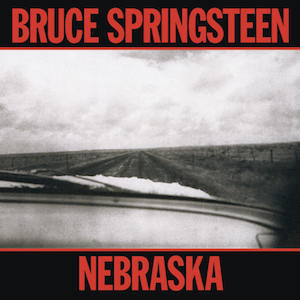A Tuber Has Noted The Implications
From the department of "For Want of a Better Title"

Nebraska: Bruce Springsteen, source = wikimedia
Last week, 'scuze my moment of SQUEEEEEEE, Mary Spender distributed an article of mine in her 21st Century Musician newsletter. Yes, she has a newsletter, you can subscribe here. Sorry, just a bit more squeeeeee...
Mary is a musician after my own heart but, where the tools I had at her age were cassettes and CDs, she has Youtube, streamers and an album for download. She also grew up in the UK, rather than my little cultural backwater of Tasmania, so her reach gives me heart for the future of music. She sees music like I do. (Or do I see it like her? I'm only a retired pub rocker. I see it like she does, yes, that's it.) She sees the inequity and exploitation and rather than giving up on music or accepting the ripoffs and broken bones AC/DC sang about in the 70s, she is advocating. And she is enlisting her fellow independents to advocate with her. That's part of her plan for 21CM.
So, last week, I wrote about my desire for an application suite that would build an album/ep application of encrypted tunes that would be able to play the tunes as an app or, via payment for an unlock key, give users access to the unencrypted audio files for inclusin in their music player app or device. The encrypted player applet would be legally shareable, the content would not. This makes it easy to share and easy to pay for the files. Direct royalty. Musical shareware.
Of the folks moved enough to reply, most were taken in by "industry fear," that their music would be stolen, or by industry hype, that streaming is shareware. It isn't.
Mary gets my article. She understands the need for a system that gets the money safely from the audience and delivers it directly to the artist. No touts or spivs in bad suits, representing labels. Following my article last week as a guest writer, her article this week breaks down, using data from a Goldman Sachs article, just how little money is getting to indepedents and how much money is being funnelled to starlets, the streamers and lables.
It gets worse.
Deezer have started a purge of all the "garage bands" and "lo fi" tracks, aiming to "improve the quality of sound" on their site. As Mary points out, Bruce Springsteen's Nebraska wouldn't survive this purge were he not a big name. Nebraska was recorded on a Tascam 144, the world's first "portastudio" home recording tool. A mixer with a single sided cassette deck, running at twice cassette's normal speed, giving the user 4 tracks to record and playback 15 to 22 minutes, depending on C60 or C90 tapes. Even the vinyl and CD of Nebraska sound like a cassette. Tape his is part of the appeal. This was a haitus period in Springsteen's life. He needed to get back to basics and just make music, simple and true.
It's historically important music. But it hisses and pops. It sounds like a home recording, a good one, but a home recording. It restarted Bruce's career and Deezer would never delete it. But you or me. People at my level, even Mary's level, we're toast. A bunch of office drones, badgered by their "Pointy Haired Boss," will just "piff" really important music to the bin. Revolutionary, lofi punk? Piffed. Woody Guthry? Likely piffed. We have moved to locked away culture to purge culture in the media, entertainment and arts industry. This is a political purge, a "pogrom," make no bones! It is cultural fascism.
And, like me, Mary is cautiously optimistic. She again states the need for a distribution medium that frees the artist from the label, that empowers the artist to sell recordings directly to their audience. And I take that as, not only did she give me a brief platform to present an idea for such a tool, she gets the need for that tool! The technology is possible, yet it doesn't exist. This should scare every musician on the planet.
So, again, I state what we need is an affordable studio tool that builds self-playing album applets, where the music is deeply encrypted into the album applet. The artist gives their fans a link to download the album - tickets at a gig, links in a newsletter, a download button on their website. If the user wants the actual file, they click a button beside the track they want, a window opens, they pay the artist's price for the file, probably using something like PayPal or Square, and the applet decrypts that track and puts the now normal, unencrypted ogg or mp3 file in their Documents folder. From there the user can use it in their newly purchased song file in the desktop, phone or media device player.
I had 500 words to do last week's 21CM article. Not sure I did it justice. I am sure Mary heard me. Read my article here, and Mary's latest here. With Mary's (and others') help, we may be on the verge of a musical revolution.

Comments
Post a Comment